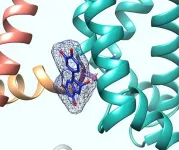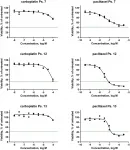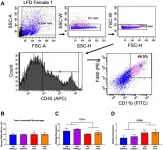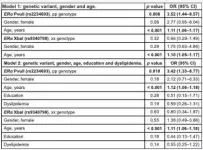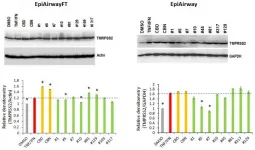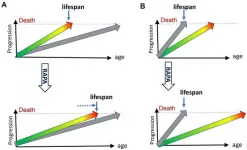(Press-News.org) Irvine, CA - March 8, 2021 - A new study from the University of California, Irvine shows that compounds in both green and black tea relax blood vessels by activating ion channel proteins in the blood vessel wall. The discovery helps explain the antihypertensive properties of tea and could lead to the design of new blood pressure-lowering medications.
Published in Cellular Physiology and Biochemistry, the discovery was made by the laboratory of Geoffrey Abbott, PhD, a professor in the Department of Physiology and Biophysics at the UCI School of Medicine. Kaitlyn Redford, a graduate student in the Abbott Lab, was first author of the study titled, "KCNQ5 potassium channel activation underlies vasodilation by tea."
Results from the research revealed that two catechin-type flavonoid compounds (epicatechin gallate and epigallocatechin-3-gallate) found in tea, each activate a specific type of ion channel protein named KCNQ5, which allows potassium ions to diffuse out of cells to reduce cellular excitability. As KCNQ5 is found in the smooth muscle that lines blood vessels, its activation by tea catechins was also predicted to relax blood vessels - a prediction confirmed by collaborators at the University of Copenhagen.
"We found by using computer modeling and mutagenesis studies that specific catechins bind to the foot of the voltage sensor, which is the part of KCNQ5 that allows the channel to open in response to cellular excitation. This binding allows the channel to open much more easily and earlier in the cellular excitation process," explained Abbott.
Because as many as one third of the world's adult population have hypertension, and this condition is considered to be the number one modifiable risk factor for global cardiovascular disease and premature mortality, new approaches to treating hypertension have enormous potential to improve global public health. Prior studies demonstrated that consumption of green or black tea can reduce blood pressure by a small but consistent amount, and catechins were previously found to contribute to this property. Identification of KCNQ5 as a novel target for the hypertensive properties of tea catechins may facilitate medicinal chemistry optimization for improved potency or efficacy.
In addition to its role in controlling vascular tone, KCNQ5 is expressed in various parts of the brain, where it regulates electrical activity and signaling between neurons. Pathogenic KCNQ5 gene variants exist that impair its channel function and in doing so cause epileptic encephalopathy, a developmental disorder that is severely debilitating and causes frequent seizures. Because catechins can cross the blood-brain barrier, discovery of their ability to activate KCNQ5 may suggest a future mechanism to fix broken KCNQ5 channels to ameliorate brain excitability disorders stemming from their dysfunction.
Tea has been produced and consumed for more than 4,000 years and upwards of 2 billion cups of tea are currently drunk each day worldwide, second only to water in terms of the volume consumed by people globally. The three commonly consumed caffeinated teas (green, oolong, and black) are all produced from the leaves of the evergreen species Camellia sinensis, the differences arising from different degrees of fermentation during tea production.
Black tea is commonly mixed with milk before it is consumed in countries including the United Kingdom and the United States. The researchers in the present study found that when black tea was directly applied to cells containing the KCNQ5 channel, the addition of milk prevented the beneficial KCNQ5-activating effects of tea. However, according to Abbott, "We don't believe this means one needs to avoid milk when drinking tea to take advantage of the beneficial properties of tea. We are confident that the environment in the human stomach will separate the catechins from the proteins and other molecules in milk that would otherwise block catechins' beneficial effects."
This hypothesis is borne out by other studies showing antihypertensive benefits of tea regardless of milk co-consumption. The team also found, using mass spectrometry, that warming green tea to 35 degrees Celsius alters its chemical composition in a way that renders it more effective at activating KCNQ5.
"Regardless of whether tea is consumed iced or hot, this temperature is achieved after tea is drunk, as human body temperature is about 37 degrees Celsius," explained Abbott. "Thus, simply by drinking tea we activate its beneficial, antihypertensive properties."
INFORMATION:
This study was supported in part by the National Institutes of Health, National Institute of General Medical Sciences, National Institute of Neurological Disorders and Stroke, the Lundbeck Foundation and the Danmarks Frie Forskningsfond.
About the UCI School of Medicine
Each year, the UCI School of Medicine educates more than 400 medical students, and nearly 150 doctoral and master's students. More than 700 residents and fellows are trained at UCI Medical Center and affiliated institutions. The School of Medicine offers an MD; a dual MD/PhD medical scientist training program; and PhDs and master's degrees in anatomy and neurobiology, biomedical sciences, genetic counseling, epidemiology, environmental health sciences, pathology, pharmacology, physiology and biophysics, and translational sciences. Medical students also may pursue an MD/MBA, an MD/master's in public health, or an MD/master's degree through one of three mission-based programs: the Health Education to Advance Leaders in Integrative Medicine (HEAL-IM), the Leadership Education to Advance Diversity-African, Black and Caribbean (LEAD-ABC), and the Program in Medical Education for the Latino Community (PRIME-LC). The UCI School of Medicine is accredited by the Liaison Committee on Medical Accreditation and ranks among the top 50 nationwide for research. For more information, visit som.uci.edu.
HOUSTON - (March 8, 2021) - Health care teams must prepare for anything, including the unconventional work environments brought about by a global pandemic and social unrest.
Multiracial medical team having a discussion as they stand grouped together around a tablet computer on a stair well, overhead view
Open communication and trust are essential for successful teamwork in challenging health care situations, as detailed in "Building effective healthcare team development interventions in uncertain times: Tips for success." The paper was authored by researchers at Rice University, the University of Texas MD Anderson ...
Squids have long been a source of fascination for humans, providing the stuff of legend, superstition and myth. And it's no wonder -- their odd appearances and strange intelligence, their mastery of the open ocean can inspire awe in those who see them.
Legends aside, squids continue to intrigue people today -- people like UC Santa Barbara professor Daniel Morse -- for much the same, albeit more scientific, reasons. Having evolved for hundreds of millions of years to hunt, communicate, evade predators and mate in the vast, often featureless expanses of open water, squids have developed some of the most sophisticated skin in the animal kingdom.
"For centuries, people have been amazed at the ability of squids to change the color and patterns of their skin -- which they ...
The perils of machine learning - using computers to identify and analyze data patterns, such as in facial recognition software - have made headlines lately. Yet the technology also holds promise to help enforce federal regulations, including those related to the environment, in a fair, transparent way, according to a new study by Stanford researchers.
The analysis, published this week in the proceedings of the Association of Computing Machinery Conference on Fairness, Accountability and Transparency(link is external), evaluates machine learning techniques designed to support a U.S. Environmental Protection Agency (EPA) initiative to reduce ...
GAINESVILLE, Fla. --- Evolutionary arms races between marine animals overhauled ocean ecosystems on scales similar to the mass extinctions triggered by global disasters, a new study shows.
Scientists at Umeå University in Sweden and the Florida Museum of Natural History used paleontological databases to build a multilayered computer model of the history of marine life over the last 500 million years. Their analysis of the fossil record closely echoed a seminal 1981 study by paleontologist J. John Sepkoski - with one key difference.
Sepkoski's ground-breaking statistical work showed abrupt ocean-wide changes in biodiversity about 490 and 250 ...
Oncotarget published "Chemotherapy sensitivity testing on ovarian cancer cells isolated from malignant ascites" which reported that the authors aim is to determine the feasibility of cell proliferation assays of tumor cells isolated from malignant ascites to predict in vitro chemotherapy sensitivity, and to correlate these results with clinical outcome.
Cell samples were enriched for tumor cells and EOC origin was confirmed by intracellular staining of CK7, surface staining of CA125 and EpCAM, and HE4 gene expression.
In vitro sensitivity to chemotherapy was determined in cell proliferation assays using intracellular ATP content as an indirect measure of cell number.
In twelve of ...
Oncotarget published "High-fat diet-fed ovariectomized mice are susceptible to accelerated subcutaneous tumor growth potentially through adipose tissue inflammation, local insulin-like growth factor release, and tumor associated macrophages" which reported that the association between obesity and colorectal cancer (CRC) risk has been well established. This relationship appears to be more significant in men than in women, which may be attributable to sex hormones - controlled animal studies to substantiate these claims and the mechanisms involved are lacking. MC38 murine colon adenocarcinoma ...
Oncotarget recently published "Estrogen receptor α polymorphism is associated with dementia in a Brazilian cohort" which reported that the growth of the elderly population is a worldwide phenomenon and it is associated with chronic diseases, including dementia.
In this scenario, the present study aimed to evaluate a possible association of estrogen receptor α polymorphisms with dementia in a Brazilian cohort.
The genotyping for the ERα PvuII and XbaI polymorphisms were performed by polymerase chain reaction-restriction fragment length polymorphism.
The ERα PvuII pp genotype was associated with a higher odds ratio for dementia (OR = 3.42, 95% CI = 1.33-8.77, p = 0.01, ...
Here is a link to a free Altmetric Report on this Research Output
Aging-US published "Hyperbaric oxygen therapy increases telomere length and decreases immunosenescence in isolated blood cells: a prospective trial" which reported that the aim of the current study was to evaluate whether hyperbaric oxygen therapy (HBOT) affects telomere length (TL) and senescent cell concentrations in a normal, non-pathological, aging adult population.
Thirty-five healthy independently living adults, aged 64 and older, were enrolled to receive 60 daily HBOT exposures.
Whole blood samples were collected at baseline, at the 30th and 60th session, and 1-2 weeks following the last HBOT session.
Telomeres ...
Aging-US published "In search of preventive strategies: novel high-CBD Cannabis sativa extracts modulate ACE2 expression in COVID-19 gateway tissues" which reported that Cannabis sativa, especially those high in the anti-inflammatory cannabinoid cannabidiol, has been found to alter gene expression and inflammation and harbour anti-cancer and anti-inflammatory properties.
Working under a Health Canada research license, the Aging-US authors developed over 800 new C. sativa cultivars and hypothesized that high-CBD C. sativa extracts may be used to down-regulate ...
Aging-US published "DNA- and telomere-damage does not limit lifespan: evidence from rapamycin" which reported that failure of rapamycin to extend lifespan in DNA repair mutant and telomerase-knockout mice, while extending lifespan in normal mice, indicates that neither DNA damage nor telomere shortening limits normal lifespan or causes normal aging.
Dr. Mikhail V. Blagosklonny said, "As a provocative title has recently announced, 'rapamycin fails to extend lifespan in DNA repair -deficient mice' [1]. The word 'fails' implies bad news. Rapamycin tried but failed. Yet, it is expected that the anti-aging ...
